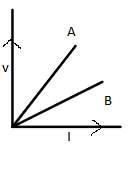
V-I graph for two wires \[A\] and \[B\] are shown in the figure. If both wires are of the same length and same thickness. which of two is made of material of high resistivity? Give justification for your answer.


Answer
515.3k+ views
Hint: The \[V - I\] Characteristic Curves is the short form of Voltage - Current. \[V - I\] characteristic curves used as a tool to define and understand the basic parameters of a component. This \[V - I\] graph determines the relation between current flows in an electronic device and voltage applied across its ends. The Voltage- current graph gets valuable information about the resistance and breaks down an electronic device and it explains electrical or electronic device operates.
Formula used:
To find voltage multiply current and resistance.
\[\;V = IR\]
Complete step by step answer:
Greater will be the resistance of a metallic wire if greater than the slope of \[V - I\] the graph. In the \[V - I\] graph, the wire \[A\] has a greater slope than \[B\] slope. Hence, greater resistance in wire \[A\].
Resistance depends on the nature of the material of the metallic wire for the wires of the same length and same thickness.
This graph is defined using ohm’s law,\[\;V = IR\] here \[V\] is voltage, \[I\] is current, and \[R\] is resistance.
The current or $I = \dfrac{V}{R}$ whereas \[I\] that is current.
The gradient of the wire \[A\] has a higher inclination hence the gradient is higher than that of the wire \[B\]. Current flowing is directly proportional to the voltage $V$ and inversely proportional to the \[r\] resistance
Note: \[V - I\]and \[I - V\] the graph shows the relationship between current and voltage.
In \[V - I\] graph, we take $V$ as $x$ axis and \[I\] as $y$ axis
But in the \[I - V\] graph, we take \[I\] as the \[x\] axis and $V$ as $y$ axis.
The slope of the \[V - I\] graph provides resistance as a result. Reciprocal Slope of \[I - V\] graph provides resistance.
Formula used:
To find voltage multiply current and resistance.
\[\;V = IR\]
Complete step by step answer:
Greater will be the resistance of a metallic wire if greater than the slope of \[V - I\] the graph. In the \[V - I\] graph, the wire \[A\] has a greater slope than \[B\] slope. Hence, greater resistance in wire \[A\].
Resistance depends on the nature of the material of the metallic wire for the wires of the same length and same thickness.
This graph is defined using ohm’s law,\[\;V = IR\] here \[V\] is voltage, \[I\] is current, and \[R\] is resistance.
The current or $I = \dfrac{V}{R}$ whereas \[I\] that is current.
The gradient of the wire \[A\] has a higher inclination hence the gradient is higher than that of the wire \[B\]. Current flowing is directly proportional to the voltage $V$ and inversely proportional to the \[r\] resistance
Note: \[V - I\]and \[I - V\] the graph shows the relationship between current and voltage.
In \[V - I\] graph, we take $V$ as $x$ axis and \[I\] as $y$ axis
But in the \[I - V\] graph, we take \[I\] as the \[x\] axis and $V$ as $y$ axis.
The slope of the \[V - I\] graph provides resistance as a result. Reciprocal Slope of \[I - V\] graph provides resistance.
Recently Updated Pages
A man running at a speed 5 ms is viewed in the side class 12 physics CBSE

The number of solutions in x in 02pi for which sqrt class 12 maths CBSE

State and explain Hardy Weinbergs Principle class 12 biology CBSE

Write any two methods of preparation of phenol Give class 12 chemistry CBSE

Which of the following statements is wrong a Amnion class 12 biology CBSE

Differentiate between action potential and resting class 12 biology CBSE

Trending doubts
What are the major means of transport Explain each class 12 social science CBSE

Which are the Top 10 Largest Countries of the World?

Draw a labelled sketch of the human eye class 12 physics CBSE

Explain sex determination in humans with line diag class 12 biology CBSE

Explain sex determination in humans with the help of class 12 biology CBSE

Differentiate between homogeneous and heterogeneous class 12 chemistry CBSE




